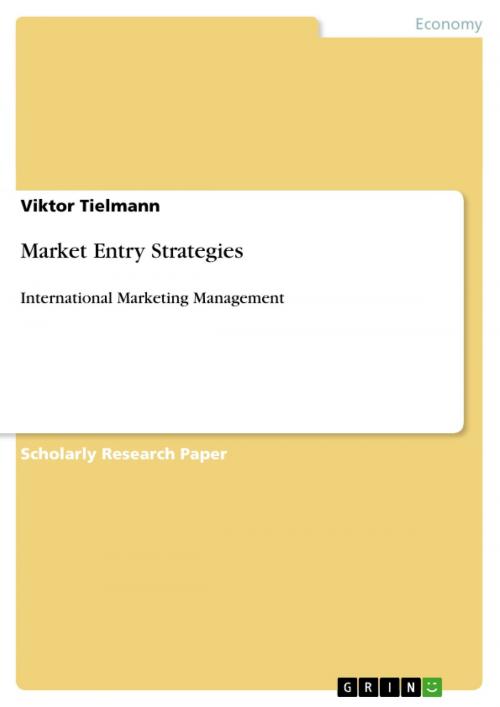| Author: | Viktor Tielmann | ISBN: | 9783640672394 |
| Publisher: | GRIN Publishing | Publication: | July 29, 2010 |
| Imprint: | GRIN Publishing | Language: | English |
| Author: | Viktor Tielmann |
| ISBN: | 9783640672394 |
| Publisher: | GRIN Publishing |
| Publication: | July 29, 2010 |
| Imprint: | GRIN Publishing |
| Language: | English |
Research Paper (undergraduate) from the year 2010 in the subject Business economics - Marketing, Corporate Communication, CRM, Market Research, Social Media, grade: 1,0, University of Applied Sciences Fulda, course: International Marketing Management, language: English, abstract: Globalization has increased the competition amongst firms. There are more and more companies which are motivated to conquer foreign markets and enlarge their presence on these markets. For multiple reasons, companies adopt modes to enter foreign markets and find new channels of distribution. Choosing the right and appropriate market entry strategy has a growing importance. As a matter of fact, companies should align their strategy to their objectives and adapt them to the foreign markets environment. There are numerous different entry strategies which are all linked to different entry modes, different amounts of risks or costs. From the least costly mode to the most expensive one we distinguish three main strategies: Export is characterized by the transportation of finished goods from one country to another. The distribution on site is done by an intermediary or by foreign based distributors or agents. Joint Venturing includes different characteristics of various joint contracts with firms to produce or promote services or products. Direct investment is, when a company decides to invest directly into a foreign country by either establish an assembly operation, a wholly-owned operation as well as a merge or an acquisition. Each of the market entry strategy has both, advantages and disadvantages. The less costly the strategy is, the less control the company has over the distribution channel. Consequently, the company depends more or less on foreign institutions or foreign partners. All in all a company has to figure out for itself which strategy to choose, according to its particular situation, financial as well as economical and environmental. Therefore, before entering a market, a previous comprehensive research and analysis of the target market and its economic environment is indispensable to achieve a successful launch into an unknown market.
Research Paper (undergraduate) from the year 2010 in the subject Business economics - Marketing, Corporate Communication, CRM, Market Research, Social Media, grade: 1,0, University of Applied Sciences Fulda, course: International Marketing Management, language: English, abstract: Globalization has increased the competition amongst firms. There are more and more companies which are motivated to conquer foreign markets and enlarge their presence on these markets. For multiple reasons, companies adopt modes to enter foreign markets and find new channels of distribution. Choosing the right and appropriate market entry strategy has a growing importance. As a matter of fact, companies should align their strategy to their objectives and adapt them to the foreign markets environment. There are numerous different entry strategies which are all linked to different entry modes, different amounts of risks or costs. From the least costly mode to the most expensive one we distinguish three main strategies: Export is characterized by the transportation of finished goods from one country to another. The distribution on site is done by an intermediary or by foreign based distributors or agents. Joint Venturing includes different characteristics of various joint contracts with firms to produce or promote services or products. Direct investment is, when a company decides to invest directly into a foreign country by either establish an assembly operation, a wholly-owned operation as well as a merge or an acquisition. Each of the market entry strategy has both, advantages and disadvantages. The less costly the strategy is, the less control the company has over the distribution channel. Consequently, the company depends more or less on foreign institutions or foreign partners. All in all a company has to figure out for itself which strategy to choose, according to its particular situation, financial as well as economical and environmental. Therefore, before entering a market, a previous comprehensive research and analysis of the target market and its economic environment is indispensable to achieve a successful launch into an unknown market.















